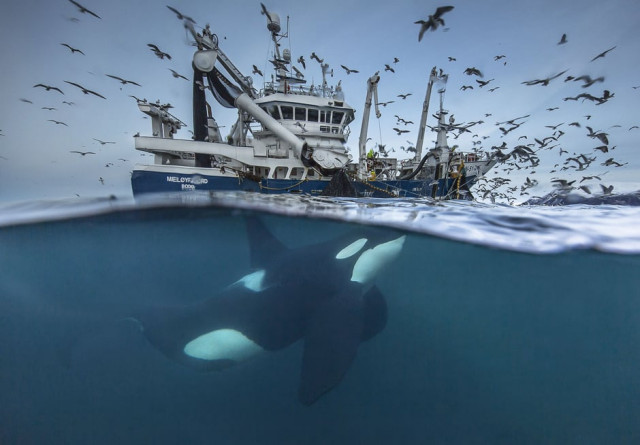In pictures: Wildlife Photographer of the Year 2016
50,000 entries and 11 finalists from the world renowned photography competition.

PHOTO: AUDUN RIKARDSEN
This year, the contest attracted a staggering 50,000 entries out of which 11 finalists have been selected.
From a curious fox to a hungry hornbill, these stunning images represent some of the world's best nature photography.
1. Splitting the catch
Sometimes it’s the fishing boats that look for the killer whales and humpbacks, hoping to locate the shoals of herring that migrate to these Arctic Norwegian waters. But in recent winters, the whales have also started to follow the boats. Here a large male killer whale feeds on herring that have been squeezed out of the boat’s closing fishing net. He has learnt the sound that this type of boat makes when it retrieves its gear and homed in on it. The relationship would seem to be a win-win one, but not always. Whales sometimes try to steal the fish, causing damage to the gear, and they can also become entangled in the nets, sometimes fatally, especially in the case of humpbacks. The search for solutions is under-way, including better systems for releasing any whales that get trapped.
 PHOTO: AUDUN RIKARDSEN
PHOTO: AUDUN RIKARDSEN2. Blast furnace
When the lava flow from Kilauea on Hawaii’s Big Island periodically enters the ocean, the sight is spectacular, but on this occasion Alexandre was in for a special treat. Kilauea (meaning ‘spewing’ or ‘much spreading’) is one of the world’s most active volcanoes, in constant eruption since 1983. As red-hot lava at more than 1,000˚C (1,832˚F) flows into the sea, vast plumes of steam hiss up, condensing to produce salty, acidic mist or rain. Alexandre witnessed the action and returned in an inflatable the following evening to find that a new crater had formed close to the shore.
 PHOTO: ALEXANDRE HEC
PHOTO: ALEXANDRE HEC3. The disappearing fish
In the open ocean, there’s nowhere to hide, but the lookdown fish – a name it probably gets from the steep profile of its head, with mouth set low and large eyes high – is a master of camouflage. Recent research suggests that it uses special platelets in its skin cells to reflect polarised light (light moving in a single plane), making itself almost invisible to predators and potential prey. The platelets scatter polarised light depending on the angle of the sun and the fish, doing a better job than simply reflecting it like a mirror. This clever camouflage works particularly well when viewed from positions of likely attack or pursuit.
 PHOTO: LAGO LEONARDO
PHOTO: LAGO LEONARDO4. Termite tossing
Termite after termite after termite – using the tip of its massive beak-like forceps to pick them up, the hornbill would flick them in the air and then swallow them. Foraging beside a track in South Africa’s semi-arid Kgalagadi Transfrontier Park, the southernyellow-billed hornbill was so deeply absorbed in termite snacking that it gradually worked its way to within 6 meters (19 feet) of where Willem sat watching from his vehicle. Though widespread, this southern African hornbill can be shy, and as it feeds on the ground – mainly on termites, beetles, grasshoppers and caterpillars--it can be difficult for a photographer to get a clear shot among the scrub. The bird feeds this way because its tongue isn’t long enough to pick up insects as, say, a woodpecker might, and though its huge bill restricts its field of vision, it can still see the bill’s tip and so can pick up insects with precision.
 PHOTO: WILLEM KRUGER
PHOTO: WILLEM KRUGER5. Nosy neighbour
Sam knew exactly who to expect when he set his camera on the wall one summer’s evening in a suburban street in Bristol, the UK’s famous fox city. He wanted to capture the inquisitive nature of the urban red fox in a way that would pique the curiosity of its human neighbors about the wildlife around them. This was the culmination of weeks of scouting for the ideal location – a quiet, well‑ lit neighborhood, where the foxes were used to people (several residents fed them regularly) – and the right fox. For several hours every night, Sam sat in one fox family’s territory, gradually gaining their trust until they ignored his presence. One of the cubs was always investigating new things – his weeping left eye the result of a scratch from a cat he got too close to.
 PHOTO: SAM HOBSON
PHOTO: SAM HOBSON6. Golden relic
With fewer than 2,500 mature adults left in the wild, in fragmented pockets of forest in northeastern India (Assam) and Bhutan, Gee’s golden langurs are endangered. Living high in the trees, they are also difficult to observe. But, on the tiny man-made island of Umananda, in Assam’s Brahmaputra River, you are guaranteed to see one. Site of a temple dedicated to the Hindu god Shiva, the island is equally famous for its introduced golden langurs. Within moments of stepping off the boat, Dhyey spotted thegolden coat of a langur high up in a tree. The monkey briefly made eye contact and then slipped away. Today, there are just six left on the island, and, with much of the vegetation having been cleared, the leaf-eating monkeys are forced to depend mainly on junk food from visitors.
 PHOTO: DHYEY SHAH
PHOTO: DHYEY SHAH7. Collective courtship
Thousands of giant cuttlefish gather each winter in the shallow waters of South Australia’s Upper Spencer Gulf for their once-in-a-lifetime spawning. Males compete for territories that have the best crevices for egg-laying and then attract females with mesmerising displays of changing skin colour, texture and pattern. Rivalry among the world’s largest cuttlefish--up to a meter (3.3 feet) long--is fierce, as males outnumber females by up to eleven to one. A successful, usually large, male grabs the smaller female with his tentacles, turns her to face him (as here) and uses a specialised tentacle to insert sperm sacs into an opening near her mouth. He then guards her until she lays the eggs. The preoccupied cuttlefish (the male on the right) completely ignored Scott, allowing him to get close. A line of suitors was poised in the background, waiting for a chance to mate with the female (sometimes smaller males camouflage themselves as females to sneak past the male).
 PHOTO: SCOTT PORTELLI
PHOTO: SCOTT PORTELLI8. Crystal precision
Every night, not long after sunset, about 30 common pipistrelle bats emerge from their roost in a derelict house in Salamanca, Spain, to go hunting. Each has an appetite for up to 3,000 insects a night, which it eats on the wing. Its flight is characteristically fast and jerky, as it tunes its orientation with echolocation to detect objects in the dark. The sounds it makes--too high‑pitched for most humans to hear--creates echoes that allow it to make a sonic map of its surroundings. Mario positioned his camera precisely so that it was level with the bats’ exit through a broken window and the exact distance away to capture a head-on shot.
 PHOTO: MARIO CEA
PHOTO: MARIO CEA9. Swarming under the stars
Imre was captivated by the chaotic swarming of mayflies on Hungary’s River Rába and dreamt of photographing the spectacle beneath a starlit sky. For a few days each year (at the end of July or beginning of August), vast numbers of the adult insects emerge from the Danube tributary, where they developed as larvae. On this occasion, the insects emerged just after sunset. At first, they stayed close to the water, but once they had mated, the females gained altitude. They filled the air with millions of silken wings, smothering Imre and his equipment in their race upstream to lay their eggs on the water’s surface. Then they died, exhausted, after just a few hours. This ‘compensatory flight’ – sometimes as far as several kilometers upstream – is crucial to make up for the subsequent downstream drift of the eggs and nymphs, and luckily for Imre, it was happening under a clear sky.
 PHOTO: IMRE POTYO
PHOTO: IMRE POTYO10. Thistle-plucker
Try keeping a flying linnet in sight while scrambling down rocky embankments holding a telephoto lens. Isaac did, for 20 minutes. He was determined to keep pace with the linnet that he spotted while hiking in Bulgaria’s Rila Mountains, finally catching up with the tiny bird when it settled to feed on a thistle flowerhead. From the florets that were ripening, it pulled out the little seed parachutes one by one, deftly nipped off the seeds and discarded the feathery down.
 PHOTO: ISAAC AYLWARD
PHOTO: ISAAC AYLWARD11. Playing pangolin
Lance had tracked the pride for several hours before they stopped to rest by a waterhole, but their attention was not on drinking. The lions (in South Africa’s Tswalu Kalahari Private Game Reserve) had discovered a Temminck’s ground pangolin. This nocturnal, ant-eating mammal is armor-plated with scales made of fused hair, and it curls up into an almost impregnable ball when threatened. These lions just wouldn’t give up. ‘They rolled it around like a soccer ball,’ says Lance. ‘Every time they lost interest, the pangolin uncurled and tried to retreat, attracting their attention again.’ Spotting a young lion holding the pangolin ball on a termite mound close to the vehicle, Lance focused in on the lion’s claws and the pangolin’s scratched scales, choosing black and white to help simplify the composition. It was 14 hours before the pride finally moved off to hunt. The pangolin did not appear to be injured, but it died shortly after, probably not just from the stress of capture but also from being out in the heat all day.
 PHOTO: LANCE VAN DE VYVER
PHOTO: LANCE VAN DE VYVERAll the captions are provided by the photographers and WPY.


















COMMENTS
Comments are moderated and generally will be posted if they are on-topic and not abusive.
For more information, please see our Comments FAQ